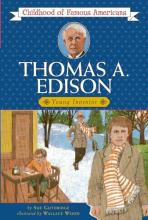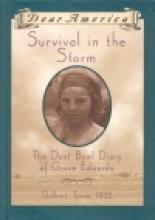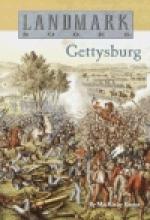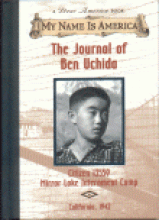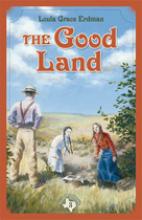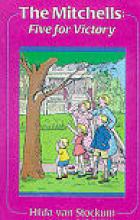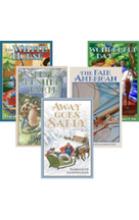United States
Thomas A. Edison: Young Inventor
This is a fascinating and often humorous story of one of the most renowned inventors of all time. As a boy, Edison was fascinated by the world around him and full of questions about everything. Although he had many mentors as a boy, his first grade teacher reacted so negatively to his natural curiosity that his mother took him out of school and taught him at home. His adventures involving chemistry, trains and printing newspapers make for enjoyable and interesting reading. Edison was clearly a boy of creativity and ingenuity and a positive role model for children of today in sharing Edison's scientific interests and natural curiosity. My six year old boy, in particular, was completely enthralled when we read this story aloud.
Copyrights 1947/1959. Several later printings.
Survival in the Storm
Survival in the Storm is the fictional story (in the format of a diary) of twelve-year old Grace Edwards who lives in Dalhart, Texas - a city near the center of the five-state area hardest hit by the infamous droughts and dust storms that plagued the Southwest for nearly a decade during the Great Depression.
The story provides a nice balance of family stability amidst hardships that give children today a fair look at the challenges of life in that time period. Grace volunteers at a hospital alongside her mother where the reader learns of the terrible illnesses associated with the dust storms. Families band together to help each other when hard times come and many leave for the "promised land" of California, only to be stuck in migrant camps where conditions are no better than at home. Throughout the story, virtues of perseverance and kindness are shown to be the things that "get people through" tough times.
Gettysburg
This book offers a glimpse into a number of aspects of the human side of the war. The author met with a number of Civil War veterans personally, and so the accounts contained within the book are very human and anecdotal. He tries to give us a sense of the flavor of life in that time period; the way people thought about each other - particularly those on opposite sides of the Potomac River.
Like many Landmark books, this probably isn't the first place you want to turn to in studying about Gettysburg - and this one isn't quite as cohesive as I would like. I think it would be most interesting and accessible to upper grade schoolers who had already become familiar with events in a general way from a textbook or from a visit to the battlefield. My 11 year old daughter tackled this independently this past year in the midst of other books on the civil war, bits and pieces of Ken Burns' Civil War Documentary and enjoyed and benefited from it.
The Swamp Fox of the Revolution
A Landmark book with complete index
The Journal of Ben Uchida
The story helps the reader to understand certain truths about the camps and the consequences of having such camps;
Many of the prisoners, particularly the children were every bit like other Americans in their loyalties, interests and lifestyles and didn't identify with Japan at all.
The camps were a very difficult place to raise children and tended to cause a decline in morals and traditions among the people. A few examples: because the living quarters are so small (one room usually divided with a blanket to accomodate two families), the children roam fairly freely about the camp, allowing for such situations as this: the main character and another boy sneak off to try to see some "naked girls" changing for a play (they are unsuccessful). As far as traditions go, it is very sad to learn that the very traditional Japanese mothers and grandmothers are forced to wear pants because the dust and wind make dresses unmanageable.
The overall injustice of the situation is clearly portrayed as well. Before they leave for the camps, families are forced to sell nearly all of their belongings at ridiculous prices (the author does also introduce us to some kind neighbors and friends who help these families in various ways, such as storing furniture for them). Some of the fathers are taken away for a time to a separate camp because the government thinks they might have specific connections with the Japanese.
After I read the book, I was at first struck that it was very depressing. All of the bad things that happen are not alleviated by a hope in God or even a hero figure on a natural level. Ben Uchida is merely recording the way things are, rather than reflecting on them (with the exception of becoming somewhat cynical). It finally struck me that what the author has done is portray many of the major aspects of the hardships of the internment camp through the eyes of one boy and have all of the different sorts of problems occur within his close circle of friends. I believe that this is somewhat unrealistic and that the book should be read by children old enough to understand this concept. Other than that (and the objectionable incident mentioned above) it really does give the reader a sense of the significance of this terrible event in American history which - even in the politically correct climate of modern America - is largely ignored. The Historical Note section (17 pages) is quite interesting. It includes some factual information about the camps, a number of black and white photos, and a brief history of the treatment of Chinese and Japanese in America (and particularly the discriminatory laws aimed against them over the years). It is also interesting that Franklin Roosevelt (who is so admired by "the left" today) is quite fairly criticized for committing such a crime against American citizens (by Executive Order) and it is interesting that it was Ronald Reagan who attempted to make some sort of retribution (however inadequate) to the Internment Camp survivors.
The Good Land
The Panhandle Series is set in the 1890's..
The Mitchells: Five for Victory
Washington D.C. is an exciting place to grow up and the children are enchanted with pets, clubs and a mysterious girl who has just moved in down the street. Mother's attempts to take in boarders and a visit from Uncle Jim and "Mr. Jenkins" keep them busy while Father is away. Pets and babies are particularly memorable characters.
There is an aspect of the story that might be troubling for young children sensitive about adoption. A neighbor who considers adopting a war refugee decides not to because the child doesn't get along with the lady's son. The fate of adopted children is discussed rather carelessly by this lady (in terms of "well, my son has to come first") and the mother of the Mitchells doesn't have any good comebacks to resolve the issue. The story resolves nicely, however, as the girl ends up finding her grandfather, but this segment might need a little explanation. My sister-in-law (who has two adopted children) found the issue troubling and put the book aside until her children were older.
The Sally Series
Hope's Revolutionary War Diary
I like this book because it weaves interesting information about this period of time throughout the story, making it an educational read. Gregory not only portrays the drama and suspense of that period, but also accurately depicts the everyday occurrences and unusual habits in daily life. In the beginning, both Hope's father and brother are gone. When they return, she finds out the hardships they have gone through. Even though this is an educational book, it is easy to read and follows more than one interesting story line. In the beginning, for example, her brother has run away to join the army and no one knows how he is. She is also concerned about her father when he is gone. Will he return home? Then to make matters worse, her best friend is not allowed to talk to her, because her friend's family sympathizes with the other side. The family also has the unpleasant task of feeding and boarding some British soldiers. Will she accidentally reveal her sympathies?
The My America Series is shorter than the Dear Diary series also published by Scholastic.

